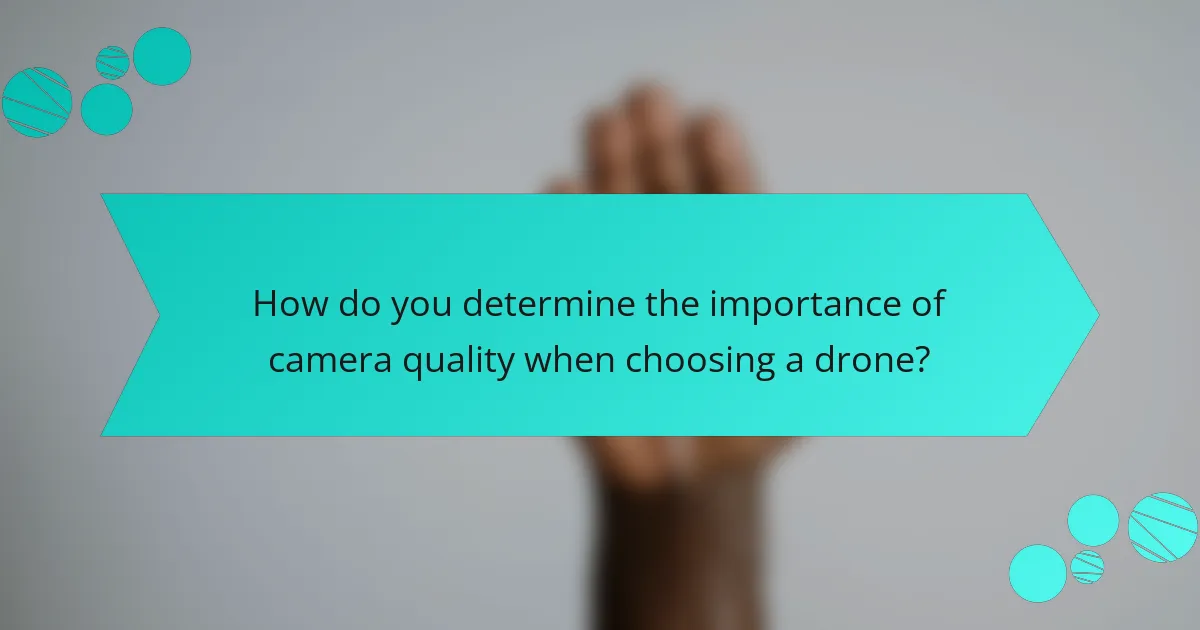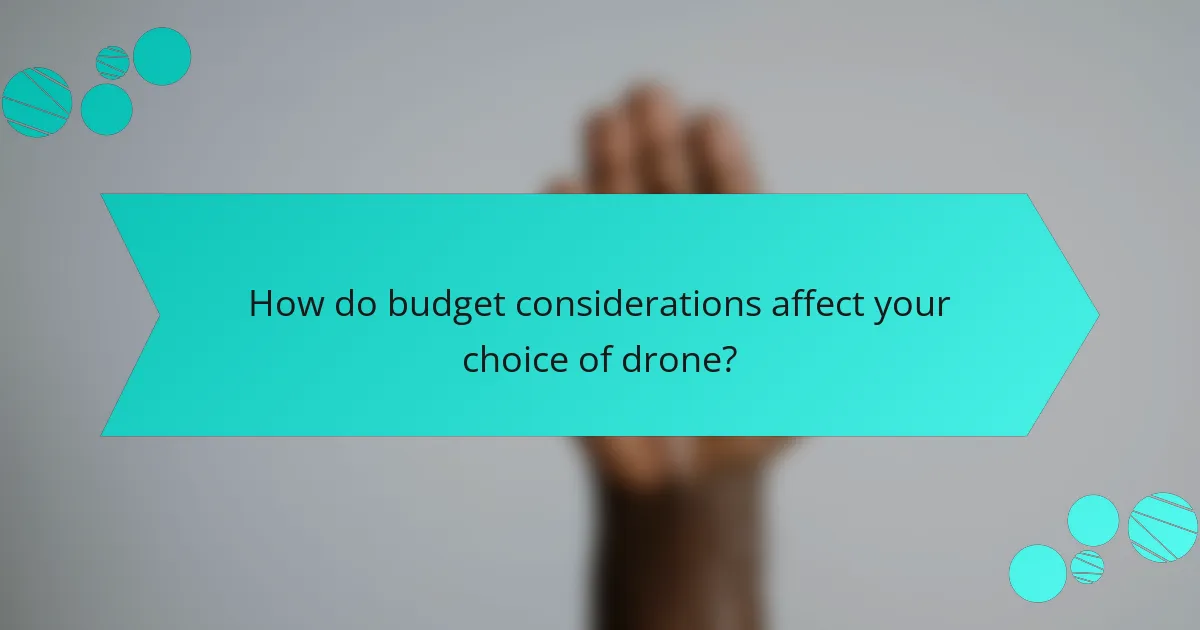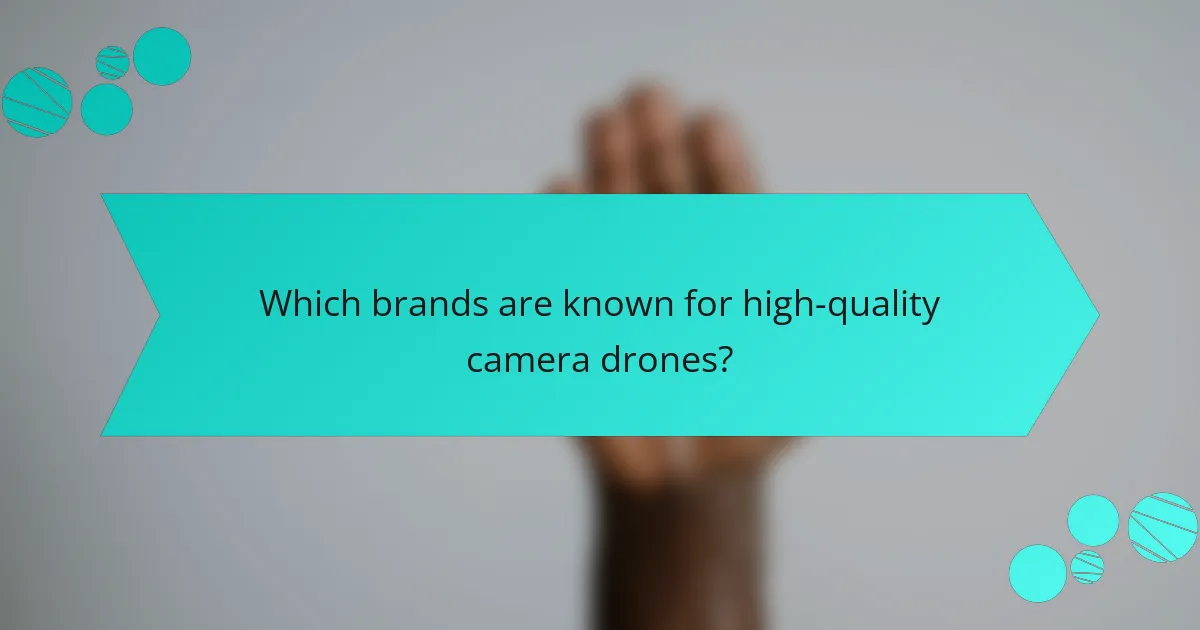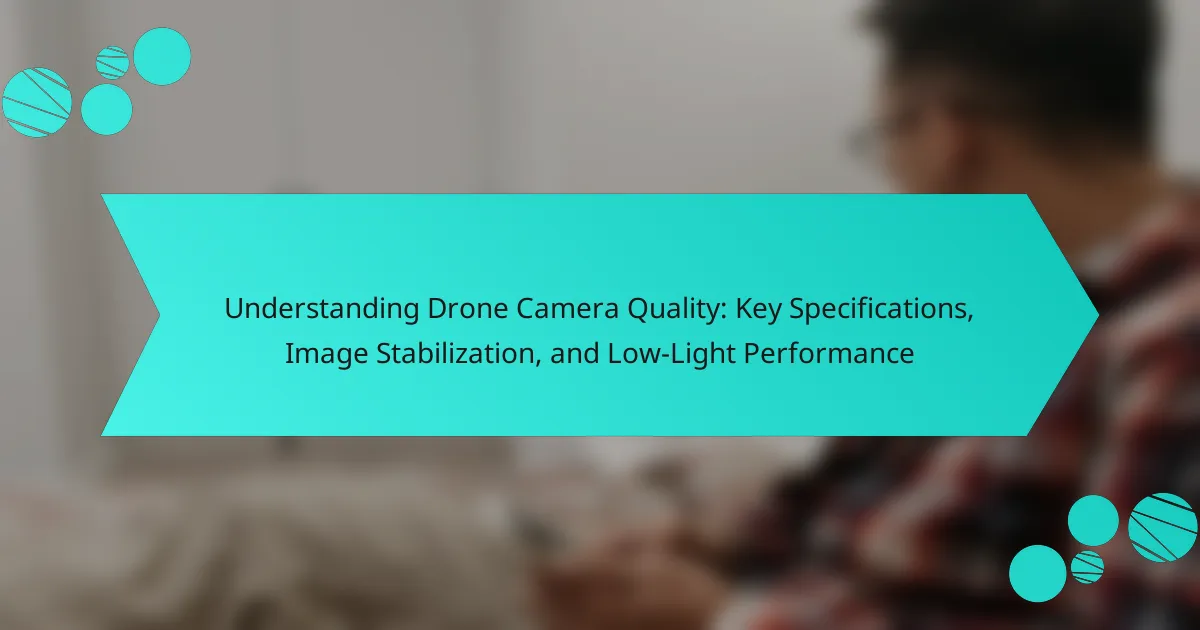
How do you determine the importance of camera quality when choosing a drone?
Camera quality is crucial when choosing a drone. It directly affects the clarity and detail of the images and videos captured. Higher resolution cameras provide sharper images. A 4K camera, for instance, offers four times the resolution of 1080p. This is essential for professional photography and videography. Additionally, camera features like lens quality and sensor size impact performance in low light. Drones with gimbal stabilization produce smoother footage. Reviews and comparisons often highlight these aspects, emphasizing the significance of camera quality in user satisfaction.
What factors should you consider regarding camera specifications?
Consider sensor size, resolution, lens quality, and aperture when evaluating camera specifications. Sensor size affects image quality and low-light performance. Higher resolution provides more detail in images. Lens quality influences sharpness and distortion levels. A wider aperture allows more light, improving performance in various lighting conditions. Additionally, check for features like image stabilization and video capabilities, which enhance overall performance. These specifications directly impact the quality of photos and videos captured by the drone.
How does resolution impact image quality in drone photography?
Resolution directly impacts image quality in drone photography. Higher resolution results in more detail and clarity in images. For instance, a 20 MP camera captures finer details compared to a 12 MP camera. Increased resolution allows for larger prints without losing quality. It also provides greater flexibility in cropping images while maintaining clarity. Additionally, higher resolution improves the overall sharpness of the image. This is crucial for professional applications like aerial surveys and real estate photography. Studies show that images with higher resolution are preferred in visual assessments.
What role does sensor size play in capturing quality images?
Sensor size significantly impacts the quality of captured images. Larger sensors can capture more light, resulting in better image quality, especially in low-light conditions. This increased light sensitivity reduces noise and enhances dynamic range. Additionally, larger sensors allow for greater depth of field control. This means photographers can achieve a more pronounced background blur, enhancing subject isolation. Research indicates that cameras with larger sensors produce images with superior detail and color accuracy. Therefore, sensor size is a critical factor in determining overall image quality in photography.
How do lens types affect the versatility of drone cameras?
Lens types significantly affect the versatility of drone cameras. Different lens types offer various fields of view and focal lengths. Wide-angle lenses capture expansive scenes, ideal for landscape photography. Telephoto lenses allow for close-up shots from a distance, enhancing detail. The choice of lens impacts the drone’s ability to adapt to various shooting scenarios. For instance, a versatile drone camera can switch between lenses for different applications. This adaptability is crucial for professional videography and photography. Research shows that drones with interchangeable lenses provide greater creative flexibility. Thus, lens types directly influence the creative potential of drone cameras.
Why is stabilization crucial for aerial photography?
Stabilization is crucial for aerial photography because it ensures clear and sharp images. Aerial environments often involve wind and movement, which can cause camera shake. This shake leads to blurry photos and shaky video footage. Stabilization technology, such as gimbals or electronic stabilization, counteracts these movements. Studies show that stabilized footage is significantly smoother, enhancing visual quality. For instance, drones equipped with 3-axis gimbals provide optimal stabilization, resulting in professional-grade imagery. Thus, stabilization directly impacts the overall quality of aerial photography.
What types of stabilization systems are commonly used in drones?
Common types of stabilization systems used in drones include gimbals, electronic stabilization, and software stabilization. Gimbals are mechanical devices that stabilize the camera by counteracting drone movements. They often feature three axes of rotation to maintain a steady shot. Electronic stabilization uses sensors and algorithms to smooth out video footage. This system can be integrated into the drone’s firmware. Software stabilization is applied during post-production to enhance video quality. Each stabilization system plays a crucial role in ensuring high-quality imagery.
How does stabilization influence video quality?
Stabilization significantly enhances video quality by reducing unwanted motion and vibrations. It allows for smoother footage, resulting in a more professional and visually appealing output. With stabilization, the camera compensates for movements, which can be especially beneficial in dynamic environments. Studies show that stabilized footage is perceived as more watchable and engaging. For instance, footage captured with gimbal stabilization can appear five times smoother than handheld shots. This improvement in quality is crucial for applications in filmmaking and aerial photography. Overall, stabilization directly contributes to the clarity and professionalism of video content.
What are the common features that enhance camera performance in drones?
Common features that enhance camera performance in drones include high-resolution sensors, optical zoom capabilities, and advanced stabilization systems. High-resolution sensors allow for capturing detailed images and videos, often exceeding 20 megapixels. Optical zoom capabilities enable closer shots without losing image quality, enhancing versatility in various shooting scenarios. Advanced stabilization systems, such as gimbals, reduce motion blur and ensure smooth footage. Additionally, adjustable aperture settings improve low-light performance. Some drones also feature HDR (High Dynamic Range) imaging for better contrast and color accuracy. These features collectively contribute to superior camera performance in aerial photography and videography.
How do features like HDR and low-light performance affect image capture?
HDR and low-light performance significantly enhance image capture quality. HDR, or High Dynamic Range, allows cameras to capture a wider range of brightness levels. This results in better detail in both highlights and shadows. Low-light performance enables cameras to produce clearer images in dim conditions. It reduces noise and enhances color accuracy in low-light scenarios. Together, these features improve overall image fidelity. Research shows that HDR can increase perceived image quality by up to 30%. Similarly, advanced low-light capabilities can allow for effective shooting in environments with light levels as low as 1 lux.
What additional functionalities can improve the overall shooting experience?
Advanced stabilization systems can significantly improve the overall shooting experience. These systems reduce vibrations and ensure smooth footage. High-quality gimbals or electronic stabilization features can enhance video clarity. Real-time monitoring functionalities allow users to adjust settings on the go. This can include live video feeds to smartphones or tablets. Intelligent flight modes, such as follow-me or waypoints, enable automated shooting. These modes allow for creative angles without manual control. Enhanced battery life ensures longer shooting sessions. This is crucial for capturing extensive footage without interruptions. All these functionalities contribute to a more professional and enjoyable shooting experience.

How do budget considerations affect your choice of drone?
Budget considerations significantly impact your choice of drone. The price range of drones varies widely, from entry-level models to high-end professional options. Lower-priced drones often have limited features and camera quality. In contrast, higher-priced drones typically offer advanced capabilities and superior imaging technology. A budget also determines the durability and battery life of the drone. For instance, more expensive drones usually come with better materials and longer flight times. Additionally, budget constraints can influence the choice of accessories and additional features. For example, a tighter budget may limit options for extra batteries or advanced stabilization systems. Ultimately, understanding your budget helps narrow down the choices to find a drone that meets both your needs and financial limits.
What price range should you expect for quality drones?
Quality drones typically range from $300 to $2,500. Entry-level models suitable for beginners start around $300. Mid-range drones with better cameras and features usually cost between $500 and $1,500. High-end drones designed for professional photography and videography can exceed $2,000. According to market analysis, the average price for a quality consumer drone is approximately $800. This price reflects the inclusion of advanced camera capabilities and stable flight performance.
How does the price correlate with camera quality and features?
Price directly correlates with camera quality and features in drones. Higher-priced drones typically feature advanced sensors and lenses. These components enhance image resolution and low-light performance. Additionally, premium models often include more sophisticated stabilization technology. This results in smoother video capture and clearer photos. Price also reflects additional functionalities like 4K video recording and higher frame rates. Research indicates that drones priced above $500 generally offer better camera specifications. For example, drones in this range often have larger sensors and better dynamic range. Thus, investing in a higher-priced drone usually results in superior camera quality and features.
What are the trade-offs between budget and performance?
Budget and performance in drones are often inversely related. A higher budget typically allows for better camera quality, advanced features, and improved flight stability. Conversely, a lower budget may limit options to basic models with reduced capabilities. For instance, drones under $500 often lack 4K video resolution and advanced stabilization technology. Research indicates that drones priced above $1,000 generally offer superior image sensors and longer flight times. Therefore, choosing a drone involves balancing desired performance features against available budget constraints.
What are the best strategies for finding value in drone purchases?
Research drone specifications thoroughly. Compare features like camera quality, flight time, and range. Assess user reviews for real-world performance insights. Consider warranty and customer support options. Evaluate the total cost of ownership, including accessories and maintenance. Look for bundles that offer additional value. Check for seasonal discounts or promotions. Analyze brand reputation and reliability in the market.
How can you identify the best deals on drones with quality cameras?
To identify the best deals on drones with quality cameras, compare prices across multiple retailers. Use online price comparison tools to find the lowest prices. Check for seasonal sales and discounts during major shopping events. Read customer reviews to assess the quality of the camera. Look for drones with high-resolution cameras and good stabilization features. Research the specifications to ensure they meet your needs. Consider refurbished models for significant savings. Many reputable brands offer warranties, which can add value to your purchase.
What role do sales and discounts play in your purchasing decision?
Sales and discounts significantly influence purchasing decisions. They create a sense of urgency and encourage immediate buying. Research shows that 70% of consumers are more likely to purchase during a sale. Discounts can enhance perceived value, making products more appealing. Additionally, consumers often compare prices, and sales can sway their choice toward a particular brand. Overall, sales and discounts play a crucial role in driving consumer behavior and decision-making.

Which brands are known for high-quality camera drones?
DJI, Autel Robotics, and Parrot are known for high-quality camera drones. DJI is the market leader, recognized for its innovative technology and reliable performance. The DJI Mavic series offers excellent camera capabilities and user-friendly features. Autel Robotics provides competitive models like the EVO series, known for their impressive image quality. Parrot, while smaller, offers unique options like the Anafi series, which features a compact design and 4K video. These brands consistently receive positive reviews for their camera performance and overall reliability in the drone market.
What are the top brands to consider for camera quality?
Canon, Sony, and Nikon are the top brands to consider for camera quality. Canon is known for its high-resolution sensors and excellent color reproduction. Sony offers advanced mirrorless technology and superior autofocus systems. Nikon is recognized for its robust build quality and exceptional low-light performance. These brands consistently receive high ratings in camera reviews and user satisfaction. Their products are widely used by professionals and enthusiasts alike. Each brand provides a range of models to suit different needs and budgets.
How does brand reputation impact your choice of drone?
Brand reputation significantly influences the choice of drone. A reputable brand often indicates reliability and quality. Consumers tend to trust established brands with positive reviews. Research shows that 70% of buyers consider brand reputation before a purchase. High reputation brands typically offer better customer support and warranty options. This assurance leads to increased customer satisfaction. Additionally, well-regarded brands often invest in advanced technology and innovation. This can result in superior camera quality and performance. Therefore, brand reputation is a crucial factor in selecting a drone.
What specific models are recommended for different budgets?
For budget-friendly drones, the Holy Stone HS720 is recommended under $300. It offers 4K camera quality and GPS features. For mid-range options, the DJI Mini SE is ideal at around $400. It provides excellent camera performance and compact design. In the premium category, the DJI Mavic Air 2 stands out at approximately $800. It features advanced camera capabilities and intelligent flight modes. Each model is well-reviewed for its respective price range, ensuring value for the investment.
What should you know about customer support and warranty when choosing a brand?
When choosing a brand, customer support and warranty are crucial factors. Effective customer support ensures assistance with issues or inquiries. Brands with responsive support often receive higher customer satisfaction ratings. Warranty coverage protects your investment against defects or malfunctions. A longer warranty period indicates the manufacturer’s confidence in their product’s durability. Research shows that brands with robust customer support tend to have lower return rates. Additionally, read customer reviews to gauge the reliability of support services. Understanding warranty terms helps avoid unexpected costs for repairs or replacements.
How does customer service influence long-term satisfaction with your drone?
Customer service significantly influences long-term satisfaction with a drone. Effective customer service provides timely support for issues like repairs and technical questions. A responsive team enhances user experience and trust in the brand. Customers are more likely to remain loyal when they feel supported. According to a study by Microsoft, 96% of consumers say customer service is important in their choice of loyalty to a brand. Positive interactions can lead to repeat purchases and recommendations. Conversely, poor customer service can lead to dissatisfaction and negative reviews. Brands with strong customer service often see higher satisfaction ratings in the drone market.
What warranty options are typically offered by leading brands?
Leading brands typically offer a range of warranty options, including standard warranties, extended warranties, and limited warranties. Standard warranties usually cover defects in materials and workmanship for one to two years. Extended warranties can provide additional coverage beyond the standard period, often for an extra fee. Limited warranties may restrict coverage to specific parts or issues. Some brands also offer accidental damage protection plans. These plans can cover damages caused by user error or accidents. Warranty options may vary by brand and model, so it’s essential to review specific terms before purchase.
What are some practical tips for selecting a drone based on camera quality?
When selecting a drone based on camera quality, prioritize the camera resolution. Look for drones with at least 12 megapixels for clear images. Consider the video recording capabilities as well. Aim for drones that support 4K video for high-definition footage. Check the camera sensor size; larger sensors typically capture better low-light performance. Evaluate the lens quality and field of view; wider angles can enhance your shots. Assess stabilization features to ensure smooth video capture. Research reviews and comparisons for specific models to gauge real-world performance. Finally, consider the brand reputation for reliability in camera technology.
The main entity of this article is drones, specifically focusing on their camera quality. The article provides a comprehensive overview of essential features to consider when selecting a drone, including camera specifications such as resolution, sensor size, and lens types. It also discusses the importance of stabilization for aerial photography, budget considerations when choosing a drone, and brand recommendations known for high-quality camera performance. Additionally, practical tips for evaluating camera quality and maximizing value in drone purchases are outlined, ensuring readers make informed decisions based on their needs and financial constraints.



